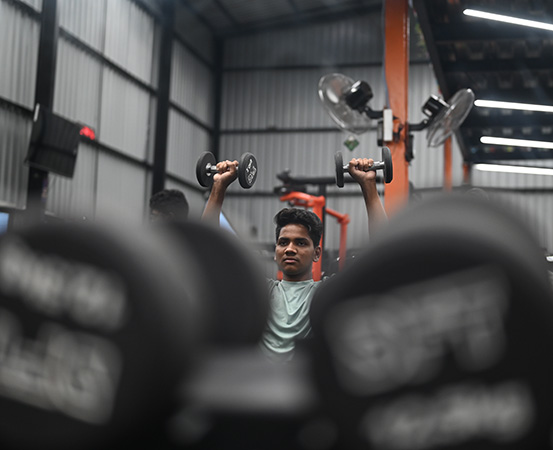
A typical gym would have all sorts of characters — from the reluctant to the hyper-driven. Keeping the extremes in the mix aside, if you scan through regular gym-goers, you are bound to notice the two main types of lifters — people who lift light weights for more reps and those who lift heavy for less than five reps. Both are targeting the same results — muscle growth and strength gains — but the chosen path is different, one opting for training volume while the other sticking to training intensity.
Training intensity as well as volume aid muscle growth and strength building, albeit in different ways, with pros and cons as well. Both will help develop overall fitness. However, there is an optimum way, a balancing act, where you get the best of both.
Training volume and muscle growth
Training volume refers to the total amount of work performed during a training session.
“Training volume is basically defined by the number of sets and repetitions as well as the amount of load exerted on your body [during a lifting session],” says Sudam Shelar, a fitness coach and samwandong master from Mumbai. “For example, the weight you lift during squat, deadlift, bench press, etc. How much your muscles work and the degree of muscle growth (hypertrophy) depends on the number of repetitions and sets.”
By subjecting your muscles to repeated contractions through exercises, you create mechanical tension that stimulates muscle protein synthesis, the process responsible for repairing and strengthening muscle fibres. This, in turn, leads to gain in muscle mass.
A study published in the Journal Medicine and Science in Sports and Exercise found that an increase in muscle hypertrophy follows a dose–response relationship, with greater gains achieved through higher training volumes. Those seeking to maximise muscle growth need to allot a greater amount of time in the weekly schedule to achieve higher training volumes. However, the study also found that volume also does not necessarily increase strength levels.
Training intensity and muscle growth
Training intensity refers to the level of effort and resistance applied during a workout.
“It is defined by the amount of weight you lift per repetition,” says Shelar. “Training for muscular strength should consist of one to ten reps at 70-80 percent of your one rep maximum per set. Three to four sets should be done.” says Shelar.
One rep maximum (RM) refers to the highest weight you can lift while doing a single rep of an exercise.
Research suggests high-intensity training can be a powerful catalyst for muscle growth. A study published in Physiological Reports indicates that a high-intensity, (3 to 5 RM. 3 RM refers to the heaviest weight that you can lift three times), low-volume resistance training program utilising a long rest interval (three minutes) is more advantageous than a moderate intensity, high-volume (10–12 RM) program utilising a short rest interval (1 minute) for stimulating upper body strength gains and muscle hypertrophy. The study also emphasises that training intensity over volume may provide an advantage for accelerating muscle growth and strength gains in a short-term training cycle.
Intensity creates metabolic stress within the muscles, stimulating hormones like testosterone and growth hormone, which are critical for muscle growth. Also, higher training intensity engages a greater number of muscle fibres, activating them to a higher degree and forcing them to grow.
“Exercise intensity is usually either low, moderate or vigorous. When you work out at a sufficient intensity, your body grows stronger, and you see improvements in your body fat percentage, strength and stamina,” says Shelar.
Maintaining balance for best results
The key to any workout lies in the principle of progressive overload. By gradually increasing the demands placed on your muscles over time, you allow for continuous growth and adaptation.
“Principles of volume and intensity depend on lifting weights and continuously increasing the volume, including total number of sets and repetitions,” says Shelar. “This surely works for beginners. But it only works for a certain amount of time.”
Soon after the beginning phase, it’s better to establish a baseline of moderate training volume and intensity that challenges your muscles without overwhelming them.
“In weight training exercises, the number of repetitions and how much work you do with the right form and technique matters,” says Shelar. Form will build more muscle and strength over time. This gradual increase stimulates muscle growth without risking overtraining or injury.
When there are time constraints, one should incorporate periods of high-intensity training into the routine.
“More reps and less weight improve endurance levels,” says Shelar. “As you add more weights along with fewer reps and sets, your strength as well as your muscle growth increases.”
To accomplish this, one can use advanced training techniques like supersets, drop sets or explosive movements as well. If you consistently feel fatigued or experience excessive soreness, it may be a sign to take a step back and adjust the intensity or volume of your training to prioritise recovery.
Periodised training leads to better gains. Structured cycles or phases of focused volume training followed by intensity training can create systematic progression. This approach keeps your body guessing and promotes continuous adaptation and gains.
Takeaways
- Training volume is the total amount of work performed during a training session. An increase in volume provides the stimulus for muscle growth by creating mechanical tension and initiating muscle protein synthesis.
- Training intensity refers to the level of effort and resistance applied. High-intensity training stimulates muscle growth by creating metabolic stress and engaging a greater number of muscle fibres, leading to muscle hypertrophy.
- Gradually increasing the training volume over time, while incorporating periods of high-intensity training, allows for progressive overload and continuous muscle growth.

















